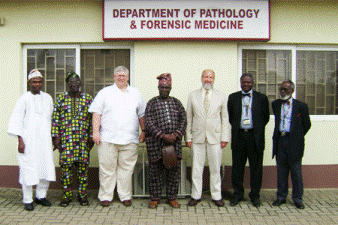Natural Resources, School of

Karl Reinhard Publications
Document Type
Article
Date of this Version
1989
Citation
Published in From the Gulf to the Rio Grande: Human Adaptation in Central, South, and Lower Pecos Texas, by Thomas R. Hester, Stephen L. Black, D. Gentry Steele, Ben W. Olive, Anne A. Fox, Karl J. Reinhard, and Leland C. Bement. Prepared by the Center for Archaeological Research at the University of Texas at San Antonio, Texas A & M University, and the Arkansas Archeological Survey. Final Report Submitted to the U.S. Army Corps of Engineers, Southwestern Division. Study Unit 3 of the Southwestern Division Archeological Overview. Contract DACW63-84-C-0149. 1989
Abstract
One of the main problems encountered in the review of the bioarcheology of Region 3 has been the limited number of sites where human skeletal material has been adequately recovered and analyzed. In the preceding chapter it was documented that less than 30% of the burials recovered from recorded sites have been reported in published literature. It was further estimated that of the 323 sites with burials, no more than 80 sites have published detailed bioarcheological reports on the burials recovered. Only 50 of these 80 reports provide individual descriptions of each burial which facilitate subsequent analyses and evaluation.
Four principal reasons probably have led to this minimal utilization of bioarcheological data in anthropological studies of Region 3. First, there have been few trained bioarcheologists with research interests centering on Region 3 skeletal samples. Second, few sites have produced large skeletal samples tempting scholars to undertake detailed bioarcheological analyses. Third, many of the recovered samples have been poorly preserved, and commonly inadequately conserved and curated. And, fourth, in the past rarely did funding agencies encourage bioarcheological research by providing adequate funding for the recovery, conservation, curation, and analysis of human skeletal remains. The result of these difficulties has been the minimal analysis of bioarcheological remains, and the general consensus (usually unspoken) that bioarcheological studies can contnbute little to the understanding of our prehistory.
While the problems outlined above are probably evident throughout North America, they seem to be a particular problem in Region 3 because this area primarily has been occupied by hunters and gatherers throughout prehistory. The consequence of this is that population densities have probably been lower than one typically sees in agriculturally based societies, and skeletal samples have accrued more slowly in the earth; thus, fewer large collections are available for excavation and more postmortem deterioration has probably occurred on those samples which do exist.
However, in the OAO area, Burnett et al. (1988) successfully assessed prehistoric adaptive efficiency through paleo pathological data, thus utilizing bioarcheological data to assess an issue of general anthropological interest. In their study area, they were able to demonstrate that although adaptive efficiency remained relatively stable, varying infection rates and metabolic disorder rates between sites and subsistence strategies could be identified.
It is the purpose of this study to determine whether the available bioarcheological literature from Region 3 in Texas lends itself to similar study. An analysis of the adaptive efficiencies of prehistoric inhabitants of Region 3 was chosen because it fits the mandates of the broader study and involves the analysis of medical disorders, which is one of the most commonly assessed biological features of reported skeletons. If such a study can be undertaken, a secondary goal is to assess the success of differing prehistoric hunter and gatherer subsistence strategies in various ecological zones within Texas. We have chosen to compare adaptive success between subregions because there appears to have been little change in hunter and gatherer adaptive strategies through time in Texas, even with the great ecological diversity within Region 3.
Included in
Archaeological Anthropology Commons, Ecology and Evolutionary Biology Commons, Environmental Public Health Commons, Other Public Health Commons, Parasitology Commons


Comments
Copyright (c) 1989 Karl Reinhard